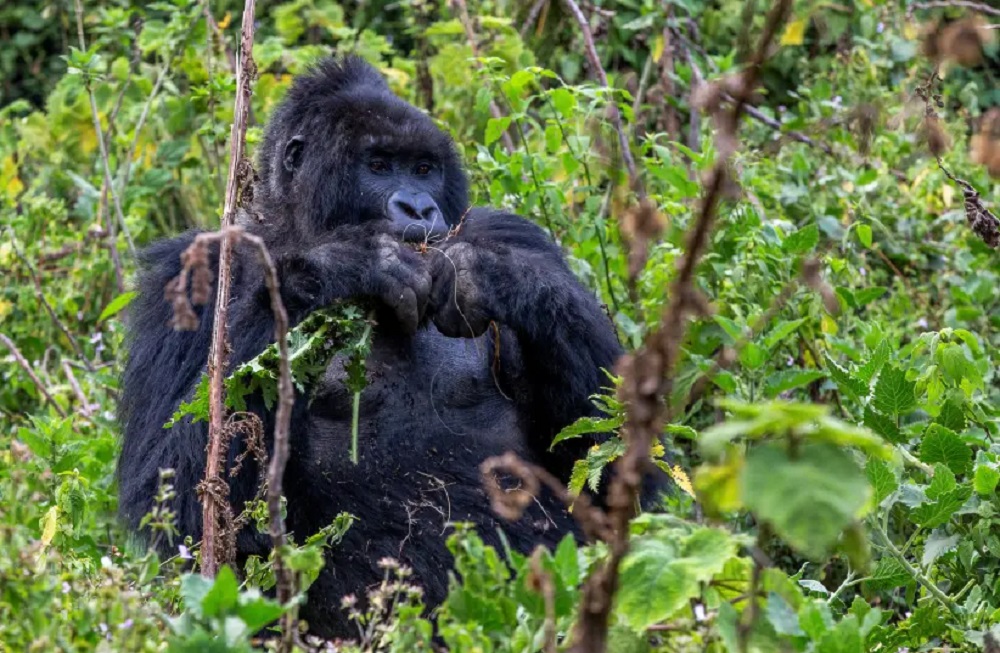
UNESCO’s Director-General Audrey Azoulay addresses delegates at the 19th Kwita Izina ceremony of giving a name to a newborn baby gorillas outside the Volcanoes National Park, near Kinigi, Musanze District, Rwanda, September 1, 2023 (photo credit: REUTERS)
Mountain gorillas share 98% of human DNA, but for decades, these « cousins of human beings » were alarmingly vulnerable to extinction in many parts of the world.
Last week, UNESCO Director-General Audrey Azoulay was in Rwanda to celebrate the significant progress made by the country in protecting these gorillas and the 40th anniversary of the UNESCO Volcanoes Biosphere Reserve.
Azoulay is the daughter of Morocco’s senior Jewish adviser to King Mohammed VI, Andre Azoulay.In Rwanda, Azoulay said, « We are seeing that it is possible to save humans’ close cousins by putting local communities at the heart of conservation strategies. »
In a telephone interview with The Jerusalem Post from France, Azoulay outlined four distinct categories of great apes. Until a recent point, all of these categories were placed on the « highly endangered » list. The mountain gorilla, for instance, experienced a significant population decline during the 20th century, primarily due to deforestation, poaching, and the transmission of diseases from humans.
In 1980, only 250 of these gorillas remained.
« Why do we have a right to suppress what is essential for another species ? » Azoulay asked.
In the past forty years, a collaboration between the national authorities, local communities, NGOs, and UNESCO has brought about a remarkable transformation. Together, they have halted the decline of mountain gorillas and facilitated their thriving in the region.

An endangered high mountain gorilla eats in the forest within the Volcanoes National Park near Kinigi, Musanze District, Rwanda, August 31, 2023. (credit: REUTERS)
Presently, over 1,000 mountain gorillas thrive in their natural habitat. The International Union for Conservation of Nature removed the mountain gorilla from the endangered species list in 2018.
Azoulay said this is a success for science, biodiversity and ethics « because we stopped destroying the habitat of this species so close to ours. »
Since 1983, Rwanda has embraced the UNESCO biosphere reserve model, establishing a cycle in which revenue from tourism is reinvested in the local community to support national parks and improve local infrastructure, including hospitals and schools.
« As we have seen in Rwanda, species conservation succeeds when local communities are placed at the heart of the conservation strategy, » Azoulay said. « Biodiversity protection measures must go hand in hand with measures that meet the needs of these local communities.
« The ancestral knowledge and skills of local communities in protecting nature must also be better recognized. Countless solutions exist locally, which need to be identified and passed on. This is the purpose of the UNESCO Convention for the Safeguarding of the Intangible Cultural Heritage, » she explained.
Azoulay was in the country for three days. During that time, she met with various authorities, scientists, forest rangers and local community members. On her last day, she participated as a « godmother » in the Kwita Izina ceremony, which celebrates newborn gorillas yearly. She also met with President Paul Kagame.
UNESCO’s work in Africa
« Worldwide, the survival of the great apes is in a critical condition. The international community must step up its efforts as quickly as possible, » Azoulay said, noting that there are also clans of these apes in Uganda and the Democratic Republic of the Congo, where UNESCO works.
In total, UNESCO protects 900,000 hectares of mountain gorilla habitat: the Volcanoes Biosphere Reserve in Rwanda, created in 1983; the Bwindi Impenetrable Forest in Uganda, a World Heritage Site since 1994; and the Virunga Park in the DRC, a World Heritage Site since 1979.
Worldwide, more than 30 UNESCO sites are home to great apes. In total, Azoulay said, there are 740 biosphere reserves worldwide.
Subscribe to view notification of our daily news
RwandaPodium © All Rights Reserved. Powered by thesublime.rw